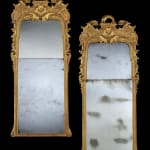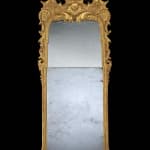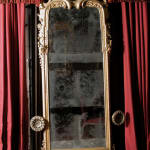THE GODOLPHIN PIER GLASSES ATTRIBUTED TO JOHN BELCHIER
W: 34” / 86.25cm
Further images
-
(View a larger image of thumbnail 1
)

-
(View a larger image of thumbnail 2
)

-
(View a larger image of thumbnail 3
)

-
(View a larger image of thumbnail 4
)

-
(View a larger image of thumbnail 5
)

-
(View a larger image of thumbnail 6
)

-
(View a larger image of thumbnail 7
)

-
(View a larger image of thumbnail 8
)

-
(View a larger image of thumbnail 9
)

Provenance
Francis Godolphin (1678-1766), 2nd Earl of Godolphin for Godolphin House, Cornwall or Stable Yard, St. James’ Palace, London and by descent
Property of a Nobleman, Christie’s London, 7 April 1983, lot 51 (GBP 60,000)
Acquired by Henry Francis Dupont, Winterthur Museum, Delaware, reputedly for his private collection
Christie’s, New York, 2 February 1991, lot 208 (USD 143,000)
Christie’s New York, 22 April 1999, Lot 143
Private Collection: East Coast, USA
Literature
Bowett, A., Early Georgian Furniture 1715-1740 (Woodbridge, 2009) p. 292, plates 6:50-1
Child, G., World Mirrors 1650-1900 (London, 1990), p. 78, fig. 51
Cornforth, J., Early Georgian Interiors (London, 2004), pp. 280-85
Edwards, R. and Jourdain, M., Georgian Cabinet-Makers, rev. ed. (London, 1946) p. 99, fig. 33
COMPARE
Pier glasses supplied by Belchier in 1723 and 1726 for John Meller, Erddig Hall, Wales (NT 1146961 & NT 1146960)
Mirror attributed to Belchier in the Metropolitan Museum of Art, New York (Accession No. 46.116)
Mirror illustrated Synge, L., Mallett’s Great English Furniture (London, 1991), p. 89, fig. 94
Publications
Beard, G. and Goodison, J., English Furniture 1500-1840 (Oxford, 1987), p. 67, fig. 4
This exceptional pair of George I gilt gesso pier glasses, attributed to John Belchier, represents the finest in early 18th-century English design. Boldly conceived and intricately carved, each features a stepped arched frame enriched with vigorous acanthus scrolls, eagle-head terminals, and a heraldic dolphin crest—unmistakably associated with the Godolphin family. These mirrors were almost certainly commissioned by the Godolphins, one of Britain’s most prominent aristocratic dynasties, whose emblematic dolphin naiant features prominently in their armorial bearings. The pierced crestings, deep relief carving, and original mercury plates reflect the superb craftsmanship characteristic of Belchier’s workshop. Architecturally strong yet richly ornamental, the mirrors embody the theatrical grandeur of the Baroque while anticipating the restraint and symmetry of the Palladian style.
They compare closely with the two pier glasses supplied by Belchier to Erddig Hall, Wales, for the principal bedchambers—on 15 July 1723 and 6 June 1726—at the substantial sums of £36 and £50. The earlier mirror shares the present pair’s stepped rectangular form, while the 1726 example is strikingly similar, with bold central scrolls and eagle heads. The £50 paid for a single mirror in 1726 suggests the exceptional value and prestige these objects held when commissioned.
The present mirrors also align with Belchier’s attributed works, such as the stepped pier glass in the Untermyer Collection at the Metropolitan Museum of Art and another formerly with Gerald Hochschild—both featuring the same distinctive combination of scrollwork and eagle-head motifs. Belchier, one of the foremost cabinetmakers of his time, was described upon his death in the London Evening Post as “for many years past a very eminent cabinetmaker.” His commission at Erddig remains his best-documented and most prestigious, likely including not only the mirrors but also the celebrated State Bed, with a tester surmounted by carved eagle heads that anticipate those seen here.
One of the most distinctive and unusual features of these mirrors is the carved dolphin naiant in the pediment—a clear heraldic device, indicating a commission for a titled client. The dolphin naiant appears in the arms of several noble families, including the Kennedys and Courtenays, but most plausibly the Godolphins of Helston and Rialton, Cornwall, where the dolphin had been an emblem since at least the 16th century. The similarity between these carvings and the parcel-gilt dolphins in the National Trust’s collection (NT 169408), believed to have served as helmet crests for Sir William Godolphin, further strengthens this attribution.
The likely patron was Francis Godolphin, 2nd Earl of Godolphin (1678–1766), a senior courtier and officeholder who served as Lord of the Bedchamber, Groom of the Stole, and Governor of the Scilly Isles. His uncle, Dr Henry Godolphin, was Dean of St Paul’s Cathedral—where Belchier had his premises and supplied fittings—providing a plausible link between maker and patron. Francis’s marriage to Lady Henrietta Churchill, daughter of the 1st Duke of Marlborough, positioned the couple at the heart of political and aristocratic society. A patron of the arts and one of the founding governors of the Foundling Hospital, he was also famed for owning one of the three foundation sires of the English thoroughbred, the Godolphin Arabian.
Adding to their distinguished history, these mirrors were later owned by Henry Francis du Pont and held in the celebrated collection at the Winterthur Museum—providing them with not only aristocratic 18th-century origins but also a prestigious 20th-century American provenance.
Combining exceptional craftsmanship, iconographic specificity, and a direct link to both an eminent maker and a prominent aristocratic lineage, this pair of pier glasses stands as one of the most significant survivals of early Georgian mirors








